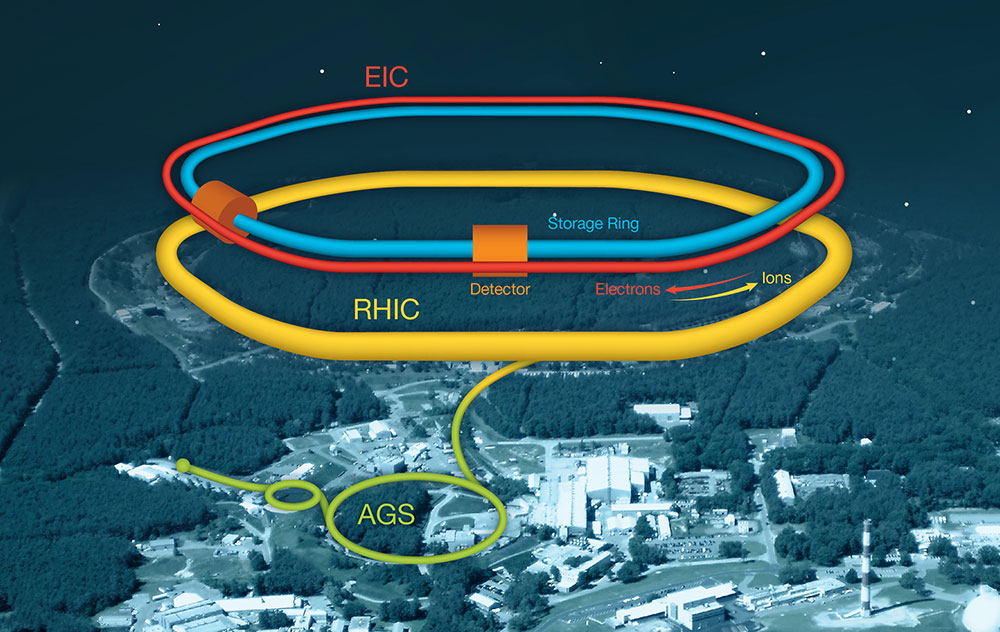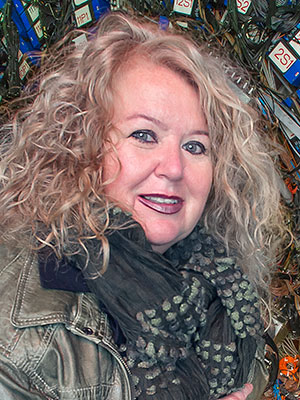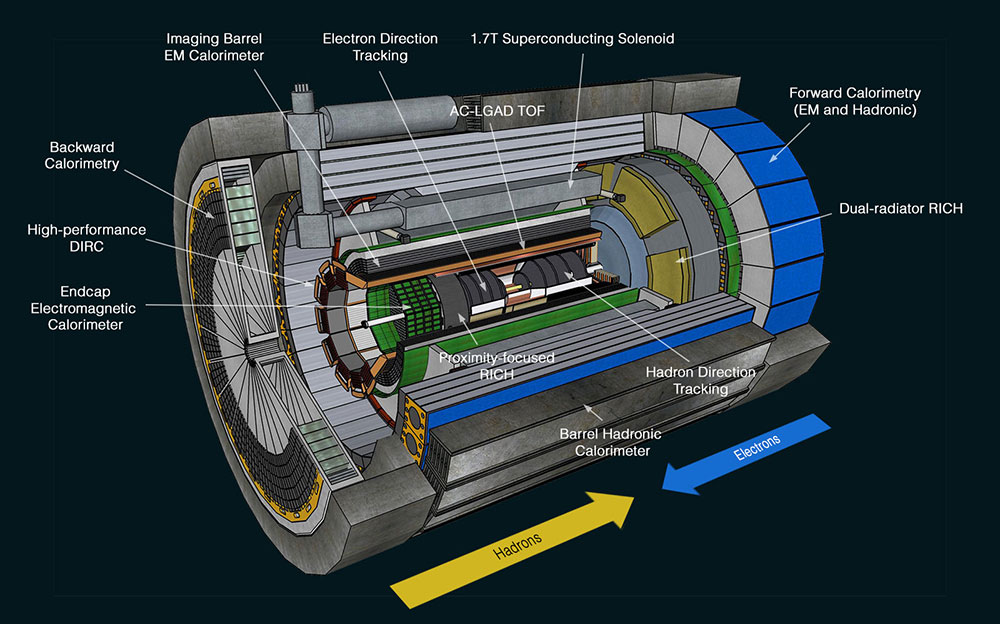MEDIA ADVISORY: Updates on the Electron-Ion Collider (EIC) at the April APS Meeting
Hear from scientists designing components and developing the science program for the next major particle collider in the U.S.
March 29, 2024
 enlarge
enlarge
The Electron-Ion Collider will be built at Brookhaven National Laboratory, reusing components of the existing Relativistic Heavy Ion Collider (RHIC). (Tiffany Bowman/Brookhaven National Laboratory)
WHAT: Scientists designing components and developing the science program for the Electron-Ion Collider (EIC) — a one-of-a-kind nuclear physics research facility being built in the U.S. — will present updates on the project at the April 2024 meeting of the American Physical Society (APS). The EIC will be constructed at the U.S. Department of Energy’s Brookhaven National Laboratory in partnership with DOE’s Thomas Jefferson National Accelerator Facility. It will have unique capabilities, including the ability to accelerate and collide beams of polarized (spin-aligned) electrons with other polarized particles — protons and lightweight ions — as well as heavier atomic nuclei. Like a CT scanner for atoms, the EIC will offer unprecedented insight into the secrets of the building blocks of visible matter and the strongest force in nature.
WHERE: SAFE Credit Union Convention Center, Sacramento, California (and virtual)
WHEN: April 3-6, 2024
Key EIC talks
Outlook and Progress of the Electron-Ion Collider Design and Construction
Sergei Nagaitsev, EIC Technical Director, Brookhaven Lab (formerly Jefferson Lab)
Friday, April 5, 10:45 a.m. – 11:12 a.m. PDT*
Ballroom A10-11, Floor 2
The EIC will be a particle accelerator that collides electrons with protons and nuclei to produce snapshots of those particles’ internal structure. It will collide polarized high-energy electron beams with polarized proton and other ion beams at unprecedented collision rates and center-of-mass energies of 20-140 billion electron volts (GeV). The electron beam, employed as a probe, will reveal the arrangement of the quarks and gluons that make up the protons and neutrons (nucleons) of nuclei. The EIC will allow us to study the “strong nuclear force” — the strongest of nature’s four fundamental forces — as well as the role of gluons in the matter within and all around us, and the nature of the spin of the nucleon, a property that makes MRI scans possible but is still not fully understood. This talk will describe the outlook and the progress of the Electron-Ion Collider design and construction at Brookhaven National Lab.
The Polarized Science Program of the Electron-Ion Collider
 enlarge
enlarge
Brookhaven Lab physicist Elke-Caroline Aschenauer, EIC Co-Associate Director for Experimental Program (Joseph Rubino/Brookhaven National Laboratory)
Elke-Caroline Aschenauer, EIC Co-Associate Director for Experimental Program, Brookhaven National Laboratory
Friday, April 5, 11:21 a.m. – 11:57 a.m. PDT
Ballroom B2, Floor 2
The EIC will address some of the most profound questions concerning the properties of visible matter and how these properties emerge from the underlying structure and dynamics of quarks and gluons. It will enable precision imaging of quarks and gluons inside protons and nuclei to determine characteristics such as their distributions in space and momentum, their roles in building the property of spin, and the properties of gluons in nuclei at high energies. The EIC’s ability to collide polarized beams — that is, beams where the particles’ spins are aligned in a particular direction — will enable the precision study of a proton’s longitudinal and transverse polarized spin structure. It will also allow us to use polarization as a vehicle to access the internal structure of protons and nuclei, which is difficult to study with unpolarized beams. This presentation will give highlights on the polarized EIC science program, introduce the needed experimental equipment, and describe the components of the EIC accelerator that are critical for the polarized science program.
Mini-symposium on EIC detector/data-tracking technology
Modern Calorimetry Technology at JLab and EIC: Past, Present and Future II
Session Chair: Alexander Somov, Staff Scientist, Jefferson Lab
Thursday, April 4, 3:45-5:33 p.m. PDT
Ballroom A8, Floor 2
The EIC will collide polarized high-energy electron beams with polarized proton and other ion beams to provide unprecedented opportunities for unlocking new details of the building blocks of visible matter. But it takes more than energetic particle collisions to explore these phenomena: It also requires state-of-the-art detector and support systems to measure the products of these collisions and prepare the reams of raw data for nuclear physicists’ interpretation into new results. Due to the asymmetric nature of EIC collisions between beams of different particle species with vastly different energies, the detector needs are unique and require a range of sophisticated systems to capture the most useful information in relation to each single detector’s orientation to the beam collision space. The Electron-Proton/Ion Collider (ePIC) Collaboration was formed to design, build, and operate the first experiment at the EIC. This mini-symposium will feature nine members of the ePIC Collaboration. Their talks will provide insights into the demanding requirements of the EIC’s unique hermetic detector systems, discuss the unique role of the distinct electromagnetic calorimeters, and reveal how inclusion of detector innovations, modern readout methods, and AI techniques will facilitate EIC science.
 enlarge
enlarge
Schematic of the ePIC detector being designed to capture details of particle collisions at the future Electron-Ion Collider (EIC). (ePIC Collaboration)
Other topics
Other Brookhaven Lab scientists will be chairing sessions, symposia, and giving talks to highlight research capabilities at Brookhaven National Laboratory’s Accelerator Test Facility (ATF), explorations of nuclear physics at the Relativistic Heavy Ion Collider (RHIC), and a wide range of other topics including dark matter, machine learning/artificial intelligence, neutrino detectors, and future colliders.
The EIC project is funded by the DOE Office of Science. ATF and RHIC are DOE Office of Science user facilities, as will be EIC when it opens for operations sometime in the 2030s.
* All times listed are in Pacific Daylight Time, the time zone for the meeting’s California location.
###
Brookhaven National Laboratory is supported by the Office of Science of the U.S. Department of Energy. The Office of Science is the single largest supporter of basic research in the physical sciences in the United States and is working to address some of the most pressing challenges of our time. For more information, visit science.energy.gov.
Follow @BrookhavenLab on social media. Find us on Instagram, LinkedIn, X, and Facebook.
2024-21805 | INT/EXT | Newsroom










